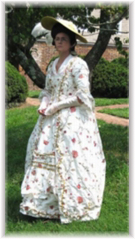So....it's been awhile and apparently, people have noticed. This is for those of you who have been kind enough to offer lots of encouragement and the occasional gentle nudge in the last year, when life overtook other plans.
That's not to say that we haven't been working - far from it! So many projects undertaken and completed in the intervening year and over the coming months, I will review some of those.
So where to begin? Let's dive in with the most recent project, a replica of an 18th C ribbonwork Needlecase held in Gawthorpe Hall. I first noticed this in the wonderful book,
18th Century Embroidery Techniques by Gail Marsh when I first got the book a few years ago and at that time, I concentrated on aerophane work, using it to trim my 18thC Bergere hat for the Williamsburg wedding. .
I have a
very long list of projects I want to complete for personal satisfaction at some point and this little needlecase kept nagging, often at the most inappropriate time.
Whilst dandelion the tubby cat snored and dreamed of catching unmentionable things, [like ribbon, perhaps?] I created a card template and drafted the embroidery onto that, then punched out small holes at the start and end points of each ribbon stitch. Then I marked up on the silk, using a pencil through the holes to accurately mark the design onto the silk surface.
Next, to embroidering the stems in backstich uisng silk floss as in the original and then selected narrow ribbons between 2 & 6mm wide from my 'stash' in white, red, brown, gold, acid yellow and green. The modern duchesse is denser than it's 18th C counterpart, so I found that I needed to work the start & end holes of each petal & leaf with a larger needle first, but the work went smoothly from there.
And voila, a hungry cat, 5 hours & 3 petals later, the embroidery is complete.
In the next post, I'll post the completed needlecase.
Happy Stitching!
Gini














